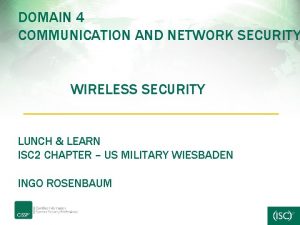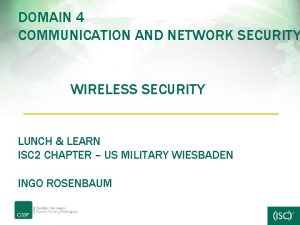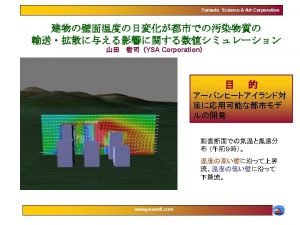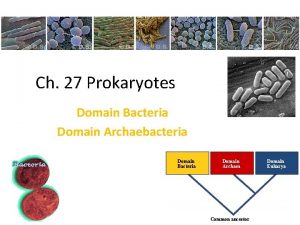Domain 4 Communication and Network Security Secure network









- Slides: 9

Domain 4 – Communication and Network Security Secure network architecture design (IP and non-IP protocols, segmentation) – Firewall and DMZ questions appear on the test Secure network components Secure communication channels – Encrytion like TLS vs SSL all the way to which way to point satellite dishes Network attacks – know of ping of death, tear drop, and every other DOS attack

Secure Network Design and Components Bastion host Exposed to the internet Hardened – You expect an attack, it’s your front line Screened subnet A bastion host between an internal and an external firewall MOST SECURE Proxy Server Can be used outbound or inbound to mask a client’s identity

Secure Network Design and Components Honeypots Lure bad people into doing bad things Lets you watch or monitor them Entice: Attract by temptation Does not mean someone downloads a file Entrap: Catch someone in a trap Downloads a payroll file

Firewalls Stateless: Stateless firewalls watch network traffic and restrict or block packets based on source and destination addresses or other static values. They are not aware of traffic patterns or data flows. A stateless firewall uses simple rule-sets that do not account for the possibility that a packet might be received by the firewall “pretending” to be something you asked for. Typically faster and perform better under heavy loads. Stateful: Stateful firewalls can watch traffic streams from end to end. They are aware of the communication paths and can implement various IP security (IPSec) functions such as tunnels and encryption. In technical terms, this means that stateful firewalls can tell what stage a TCP connection is in (Open, Open sent, synchronized, synchronization acknowledge or established), it can tell if the MTU has changed, whether packets have fragmented, etc. Better at identifying unauthorized and forged communications.

Firewalls Stateless: Stateless firewalls watch network traffic and restrict or block packets based on source and destination addresses or other static values. They are not aware of traffic patterns or data flows. A stateless firewall uses simple rule-sets that do not account for the possibility that a packet might be received by the firewall “pretending” to be something you asked for. Typically faster and perform better under heavy loads. Stateful: Stateful firewalls can watch traffic streams from end to end. They are aware of the communication paths and can implement various IP security (IPSec) functions such as tunnels and encryption. In technical terms, this means that stateful firewalls can tell what stage a TCP connection is in (Open, Open sent, synchronized, synchronization acknowledge or established), it can tell if the MTU has changed, whether packets have fragmented, etc. Better at identifying unauthorized and forged communications.

IDS/IPS Intrusion Detection A device or application that analyzes whole packets looking for known events. A log is generated detailing these events. Intrusion Prevention A device or application that analyzes whole packets, both header and payload, looking for known events. When a known event is detected the packet is rejected (inline mode only).

Secure Communication channels TLS/SSL – TLS is newer Resource for satellite dish technology: http: //resources. infosecinstitute. com/hacking-satellite-look-up-to-the-sky/

Satellite Principle Threats Tracking – Tracking over web data and software Listening – Listening with the right equipment, frequencies, and locations. Interacting – Protocols and authentication used, radio transmissions need official license. Using – Take over a bird or a TT&C [Use payloads, make pictures, transmit something] Scanning/Attacking – Anonymous proof of concept in 2010, scanning, DOS, spoofing possible Breaking – Old technologies used (x. 25, GRE) Jamming- jamming well known frequencies for satellites Mispositioning/Control – transponder spoofing, direct commanding, command reply, insertion after confirmation but prior to execution Grilling – activating all solar panels when exposed to sun, overcharging energy system Collision

Network Attacks SYN Flood Fraggle Attack A fraggle attack is a DOS attack that involves sending large amount of spoofed UDP traffic to a router’s broadcast address within a network. It is very similar to a smurf attack, which uses spoofed ICMP traffic rather than UDP traffic to achieve the same goal. Land Attack A SYN flood is a form of DOS attack in which an attacker sends a succession of SYN requests to a target’s system in an attempt to consume enough server resources to make the system unresponsive to legitimate traffic. A land attack is a layer 4 DOS attack in which the attacker sets the source and destination of a TCP segment to be the same. A vulnerable machine will crash or freeze due to the packet being repeatedly processed by the TCP stack. Teardrop attack A teardrop attack is a DOS attack that involves sending fragmented packets to a target machine. Since the machine receiving such packets cannot reassemble them due to a bug in the TCP/IP fragmentation reassembly, the packets overlap one another, crashing the target network device.
 Private security
Private security Wireless security in cryptography and network security
Wireless security in cryptography and network security Secure socket layer and transport layer security
Secure socket layer and transport layer security Secure socket layer and transport layer security
Secure socket layer and transport layer security Secure socket layer and transport layer security
Secure socket layer and transport layer security Secure socket layer and transport layer security
Secure socket layer and transport layer security Explain osi security architecture
Explain osi security architecture Security guide to network security fundamentals
Security guide to network security fundamentals Electronic mail security in network security
Electronic mail security in network security Security guide to network security fundamentals
Security guide to network security fundamentals

















